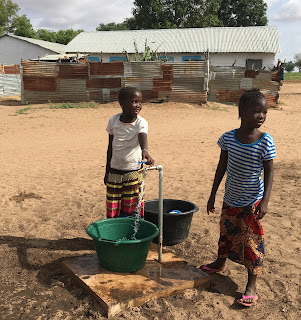Clean Drinking Water for My Village
 |
| For the first time in my village, the girls can fetch water without having to pump or haul it from a well |
The
groundwater quality is also quite good. This is predominantly because
local land uses aren’t likely to cause groundwater contamination. Much of the land in The Gambia is used for farming but the country does not have the resources for the widespread use of fertilizers and pesticides that can contaminate groundwater
aquifers if over applied. It also has very limited heavy industry and no
heavily trafficked transportation corridors in the upcountry regions - these
can also be sources of groundwater contaminants. This is all very fortunate for
the people of The Gambia because its sandy soils make the shallow, unconfined aquifers quite vulnerable to contamination.
So the good news is that good
quality groundwater is readily available throughout much of the country. The
bad news is that the methods for accessing groundwater in many villages create opportunities for their drinking water to become contaminated. Many
villages use hand-dug wells that are either covered or uncovered. Covered wells
will have a hand pump; uncovered wells will have a pulley for hauling up water
in buckets. Drinking water from covered wells is safer than uncovered wells but
– as you can see from the picture – the water is still at risk of contamination
from surface sources.
 |
| Typical covered well with a hand pump |
 |
| Waiting in line at the pump |
Long story short - - I raised funds through a combination of grants (read about "Let Girls Learn" grant program here) and online contributions from Returned Peace Corps Volunteers, family and friends to brings taps into my village. Over the last few weeks a local firm drilled a 35-meter deep bore hole with a solar-powered pump, erected a water tank and installed a network of seven taps throughout the village. This is essentially the state-of-the-art for drinking water in rural Gambia. Many of the surrounding villages already have a bore hole and taps. My village has been waiting and waiting for their day to come.
On August 8th, the water flowed freely and the women danced in celebration! And I joined them! I'm so happy for the difference this will make in their lives and the wellbeing of everyone in the village. And I feel so very fortunate that I am able to take advantage of what Peace Corps has to offer.
[Note - after playing the video you may need to refresh the page to make it reset to the right link.]
[Note - after playing the video you may need to refresh the page to make it reset to the right link.]


Comments
Post a Comment